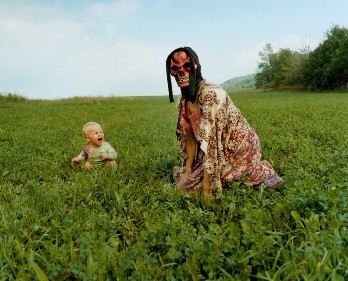Breaking in Two—Exploring Images of Motherhood

Carrying the subtitle, "A Provocative Vision of Motherhood," this group show in Santa Monica, California, explores the dual roles of artist and mother.
A curious hodgepodge of sculptures, photographs and video art lines the walls of an aging hangar nestled in the corner of the Santa Monica Airport. Although not the first exhibit to grace this space at Santa Monica Art Studios, none have been quite as startling at first glance.
Pregnant stomachs covered in plaster strips. Bronze breasts blooming bare tree branches. A photograph of a woman wearing a demon mask, while a terrified infant cries beside her (above left).
Whether painted or projected, photographed or sculpted, these images strike a dichotomy of pleasure and angst. For these artists, it’s a byproduct of being a mother.
By exploring the social perceptions of motherhood through fine and visual arts, Breaking in Two is the first exhibit of its kind. What began as a documentary following working artists who are also mothers has stemmed into an exposé of how the images of mothers have been evolving over the last several decades.
Considering both the current political and pop culture climates of contemporary America, Breaking in Two could not have come at a better time (February 11 through April 14, Arena 1 Gallery, Santa Monica).
From the battles over birth control to the media’s recoil of Jessica Simpson’s naked pregnant body on the cover of Vogue, modern motherhood is still stuck in a traditional societal convention. It’s a priceless gift and the highest role a woman can attain, yet there are certain things society refuses to acknowledge: nude pregnant bodies, postpartum depression, the sacrifice of a career and failed motherhood, among them.
These taboos have preoccupied the minds of numerous contemporary women artists who, even during and after the feminist art wave of the 1970s, are compelled to hide their maternal status and forgo making the widely disparaged “baby art.”
“We’ve changed things a lot, but still the idea of being a mother in creative arts—people view it very differently,” said artist Kim Abeles, an L.A.-based artist whose work is featured in both the exhibit and accompanying documentary.
“When you’re a woman, suddenly you look different to everybody. Their expectations become different,” Abeles said.
These expectations stem from our common perceptions of hermetic artists and mothers, who tend to be isolated by motherhood. When we think of artists, we often view them as giving themselves over completely to their art—their calling. When we think of mothers, we see them as also giving themselves over completely to their children—their assumed calling.
Both roles require sacrifice, devotion and submission. So when a woman already exchanges her identity, in the eyes of society, for that of “mother,” it leaves little room for her self-identity as an artist to not only flourish, but stand alone.
Contemporary women artists who preceded the Women’s Liberation Movement, such as Lee Krasner and Elaine de Kooning, might reject motherhood entirely, believing it was an unforgivable handicap for an artist. By forsaking motherhood, their work was taken as seriously as their male peers.
During the 1970s and ’80s, certain feminist artists made breakthroughs in art and motherhood, notably Mary Kelly and Judy Chicago. Kelly’s seminal video piece “Antepartum,” which is featured in Breaking in Two, thrusts the artist’s full-term pregnant stomach to the center of the screen. Kelly strokes her stomach in one single shot, set on loop.
As a way to celebrate childbirth and a woman’s role as mother, Chicago reinterpreted the Genesis creation narrative in “The Birth Project,” rewriting Biblical history so that Adam comes from woman and not God, a man.
Although some contemporary women artists veer into the sentimental, usually in the form of gentle portraits of mother and child, most artists have followed the lead of Kelly and Chicago. Breaking in Two shows the artist collective M.A.M.A. confronting California Civil Code 43.3, a breastfeeding law; others, such as photographer Tierney Gearon’s “Pregnancy Project” series, assert that motherhood is an art unto itself, exploring the connection between motherhood, spirituality and creation.
Feminists might be wary of the idea of motherhood being integral to a woman’s life, however, women artists today seem to say it serves as a compelling force that’s at once complementary as it is antagonistic.
This force has driven the work of many women artists, as is the case in Abeles’ photography series “Self-Portrait with Files.” The most impressive photograph in the series shows Abeles draped over a teetering, nearly ceiling-high stack of documents, photographs and newspaper clippings as she addresses that mythical search for an equilibrium between balancing work and family (right).
At some point, that stack and the woman become one, signifying an intersection rather than division.
Although many contemporary artists seem to put an emphasis on motherhood, they continue to move one art piece closer to that intersection of an artist and motherhood. It is only until then that women won’t have a need to “break in two.”
More articles by Category: Arts and culture, Feminism
More articles by Tag: Reproductive rights




























